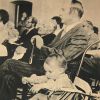For the deacon class of ’72, it was a family affair
TORONTO - When the first class for the permanent diaconate gathered for its initial orientation Sept. 16, 1972, the candidates brought along their wives and children. For those present that day, it was the beginning of many bonds that would last for years.
“I made real life-long friendships with them,” said Alexander MacGregor, one of the 33 men who met that day. “Meeting other men and their wives and their families who were dedicated, inspiring, hard workers — it was really inspiring to be involved.”
Forty years ago this month, the permanent diaconate came to English Canada with the launch of a deacons’ program in the archdiocese of Toronto. That followed the launch of similar programs in the United States, Europe and other countries. The ministry of deacons, which had been important in the early Church, was revived at Vatican II to assist in parish work and to proclaim the Gospel in the community, particularly through acts of charity.
From the first class of 33 candidates, the diaconate has spread across Canada so that today deacons are commonplace in most dioceses. Toronto alone has more than 100 active deacons and has ordained 272 deacons since 1972. Many will officially celebrate the 40th anniversary on Sept. 29 at a Mass celebrated by Bishop Vincent Nguyen, followed by a gala dinner.
Stanley MacLellan, who worked in the financial industry and had always been active in his parish, heard about the diaconate through his university pal, Fr. Paul Giroux, a member of the archdiocese of Toronto’s committee on the permanent diaconate.
“He came to my parish and we renewed our friendship,” MacLellan said. “He told me what they were trying to do. I thought it sounded interesting.”
Appointed co-ordinator of his year, MacLellan helped shape that inaugural class.
“That was an interesting two years to start, creating the program as we went along,” he said. “We got together so many times over the next two years, planning the next session in the seminary, changing as things went along.”
When the first class of deacons began its two-year course in 1972, the candidates had no idea what to expect.
“It was unusual because while we were going through the class, they were also discovering what was needed,” said MacGregor. “In retrospect, the first class got through easier than the other classes. I think from the experience of the first class, those who were in charge refined both the entrance requirements and what was being taught.”
Yes they did, but prior to 1972, the committee on the permanent diaconate in Toronto had to decide who could enter the program, how the program would run and the role of deacons within a parish.
Two members of that committee, Giroux and Msgr. John O’Mara, had attended a conference in Chicago on the permanent diaconate in 1970, bringing back two main ideas about the ideal candidate: first, they had to be more than just a volunteer, they had to be an “ambrosian model”; second, their wives must be like-minded and taken into consideration. To this day, there is a tradition of deacon wives who are just as involved as their husbands.
And just as the ideal candidate was formed, so was the structure of the program, a two-year journey that was very academic in nature. It included 10 weekend sessions, including a Sunday evening potluck with wives and children. Giroux, who became the first director of the program, made sure that family and work remained a priority to all candidates.
For MacGregor, family had to remain a priority. After all, he had 10 children.
“I was involved in several projects — school board, figure skating — and I thought I could do something different in a different field,” he said.
But keeping family a priority wasn’t the only prerequisite to be considered a good candidate for deacon. Candidates had to be over 35, in good health and mentally, emotionally and financially stable, with a good job.
As a result, the first class formed at St. Augustine’s with 33 men, 28 from the archdiocese of Toronto, and included men in their 30s, 40s and 50s, all with different backgrounds. There was a retired naval officer, an assistant superintendent of a school board, a lawyer, an insurance broker. All but two were married, and so those two took a vow of celibacy, as required for unmarried or widowed deacons.
Then-Archbishop Philip Pocock said at the time that he felt grateful to all the men in the class who felt called to serve, for different reasons, from different places in life.
Over the years, there have been many changes to the program. The academic portion is now four years long, with a class graduating every two years. More recently, a foundation year for men to decide if this is the right path for them was added in conjunction with a similar year for seminarians.
MacGregor is happy to have been a part when it was all just beginning.
“Coming up with clear direction as to what ministries were and how the formation program should work was always a challenge, but it gave lots of excitement (to my) life.”
Only a handful of deacons from that first class are still alive, including two, Tom Cresswell and Larry Rogers, who later became priests after their wives died.
But the legacy of the first class lives on, both in the basic structure of the program and in the hearts of its participants.
[issuu width=600 height=360 backgroundColor=%23222222 documentId=120910160538-19846c86f786424e98153821bd480e84 name=diaconate username=catholicregister tag=anniversary unit=px v=2]
What is a deacon?
When asked just what exactly is a deacon, Steve Pitre bursts out laughing.
“You’ve asked the question that theologians have been pondering for 50 years, and they still haven’t come up with a definitive answer,” said the co-ordinator of the permanent diaconate for the archdiocese of Toronto.
That’s because the nature of the deacon’s work is so all-encompassing and thoroughly engaged with his community that it can often be difficult to lay a strict definition to their ministry.
“The deacon is to be the icon of Christ the servant. When we talk about service, it’s in three areas: charity, liturgy and the word,” said Pitre.
Diaconate candidates in Toronto do four years of formative study and practice at St. Augustine’s Seminary. Unlike a priest, the deacon is ordained through a call to service. The ministry is open to all men between the ages of 35-59, both single and married, and, if married, requires the complete consent and support of his spouse (wives are active in their husband’s ministry).
“If he’s married, the call comes from his marriage and therefore from his family. But, in essence too, even if he’s single, it’s still coming from the family, from his support and from his friends,” said Pitre.
“While everybody seems to see us strictly in liturgy and preaching, that really comes from our service of charity. It starts with our families first, the community and then with a special emphasis on the less fortunate, the weaker members and the marginalized of our society,” said Pitre.
Indeed, in St. Ignatius’ letter to the Trallians, he notes: “… as ministers of the mysteries of Jesus Christ, the deacons should please all in every way they can; for they are not merely ministers of food and drink, but the servants of the Church of God.”
In this way, the deacon serves as a vital part of our Christian community. They work not only in parishes, but in all places where there may be need such as hospitals, prisons, even on the streets. They are the mission of service personified, bringing the liturgy of our faith and the essence of charity to all in our communities who may be at need.
[issuu width=600 height=360 backgroundColor=%23222222 documentId=120910160538-19846c86f786424e98153821bd480e84 name=diaconate username=catholicregister tag=anniversary unit=px v=2]
FORISTELL, Mo. - Deacon Richard Seveska hears all kinds of stories at his local truck stop, but he fondly remembers one particularly appreciative driver.
“I had a trucker one night say, ‘Rich, this is not a meeting of two people,” Seveska said. “It’s a meeting of two souls.’ ”
Seveska’s passion the last dozen years has been his truck-stop ministry. The deacon spends evenings saying hello to truckers, identifying himself as a chaplain and looking for people who may want to talk.


